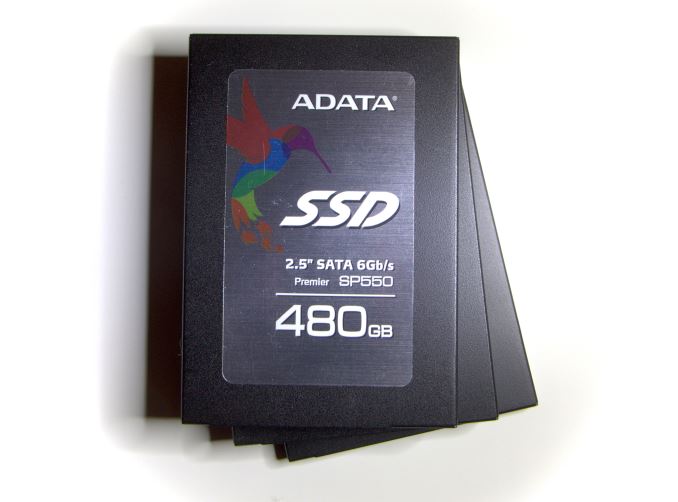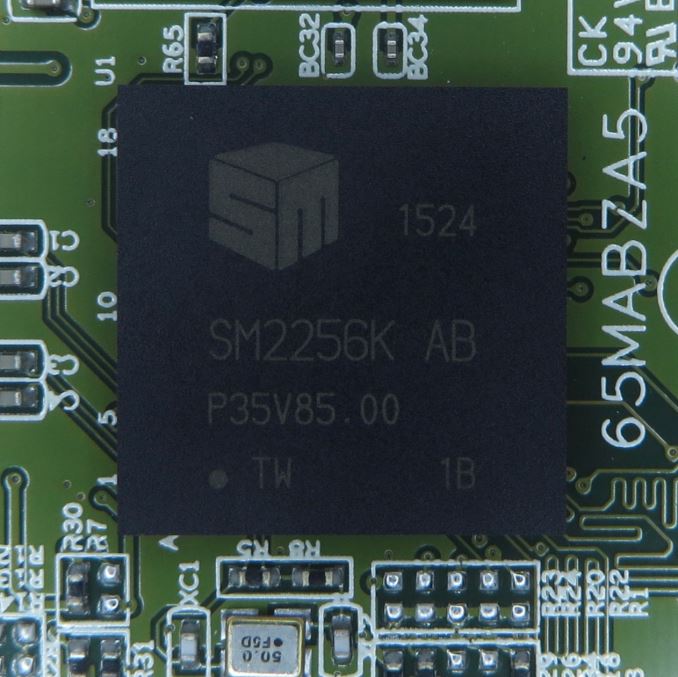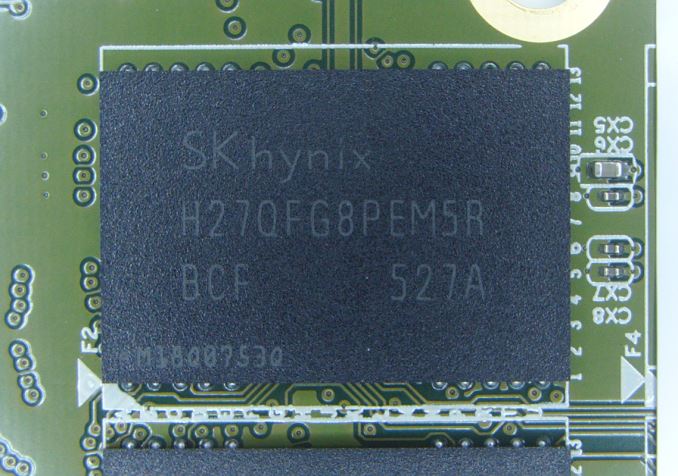The ADATA Premier SP550 SSD Review: A Second Look At Silicon Motion's SM2256 Controller
by Billy Tallis on March 23, 2016 8:30 AM EST
Silicon Motion's SM2246EN SSD controller was a highly successful solution for SSDs using MLC NAND flash. It offered a great combination of power efficiency, solid performance, and low cost. Last year we got an early look at the successor SM2256 controller for drives using TLC NAND and found that despite being made for TLC it didn't do a very good job of mitigating the performance and power consumption problems inherent to TLC NAND. At the time there were only a few mainstream TLC drives and the SM2256 was one of the first controllers designed specifically with TLC in mind. That preview was based on a reference design drive using Samsung 19nm TLC and prerelease firmware, so we were hopeful for improvement in final retail products that would be using different NAND and firmware.
In November we looked at the performance of the Crucial BX200 based on the SM2256 controller and Micron 16nm TLC NAND, and we found that the situation had gotten much worse: performance was bad and power consumption was high. In the meantime, Phison's S10 controller (and Toshiba's custom branded variant of it) became the most popular solution for TLC SSDs and the market was flooded with nearly-identical drives from new and old players in the market.
That brings us to today's review of ADATA's Premier SP550 SSD. ADATA manufactures drives with almost every controller available on the open market, and the Premier SP550 is their SM2256 offering. ADATA has in turn positioned the drive as the entry-level model of their mainstream consumer Premier product line. Meanwhile with a different choice of flash (SK Hynix 16nm TLC NAND) and updated firmware, the SP550 has the chance to partially redeem the SM2256 controller.
| ADATA Premier SP550 Specifications | ||||
| Capacity | 120GB | 240GB | 480GB | 960GB |
| Controller | Silicon Motion SM2256 | |||
| NAND Flash | SK Hynix 16nm TLC | |||
| Sequential Read | 560MB/s | 560MB/s | 560MB/s | 520MB/s |
| Sequential Write | 410MB/s | 510MB/s | 510MB/s | 490MB/s |
| Random Read IOPS | 60k | 75k | 75k | 80k |
| Random Write IOPS | 70k | 75k | 75k | 35k |
| TCG Opal Encryption | No | |||
| Power Management | Slumber and DevSleep | |||
| Warranty | 3 years | |||
| Current Retail Price | $38.99 | $57.99 | $112.99 | $219.99 |
With pricing starting at $39 for 120GB and even the 480GB model staying under $0.25/GB, the pricing is a good start, as the SP550 has consistently been one of the cheapest drives on the market. No TLC drive has yet reached a price low enough to completely excuse its shortcomings relative to MLC drives and earn an unconditional recommendation, but at least the SP550 has kept pace with the price drops in recent months. Its primary competitors are Phison/Toshiba-based SSDs with Toshiba's A19nm TLC, as their successors based on Toshiba's 15nm TLC are still new enough to the market to be selling for higher prices closer to the MSRP. This means we'll be looking at the OCZ Trion 100 as the most likely alternative, though similar drives from Silicon Power and PNY are available in the same price range and newer drives like the OCZ Trion 150 may match its price it in the near future.
| AnandTech 2015 SSD Test System | |
| CPU | Intel Core i7-4770K running at 3.5GHz (Turbo & EIST enabled, C-states disabled) |
| Motherboard | ASUS Z97 Deluxe (BIOS 2501) |
| Chipset | Intel Z97 |
| Memory | Corsair Vengeance DDR3-1866 2x8GB (9-10-9-27 2T) |
| Graphics | Intel HD Graphics 4600 |
| Desktop Resolution | 1920 x 1200 |
| OS | Windows 8.1 x64 |
- Thanks to Intel for the Core i7-4770K CPU
- Thanks to ASUS for the Z97 Deluxe motherboard
- Thanks to Corsair for the Vengeance 16GB DDR3-1866 DRAM kit, RM750 power supply, Carbide 200R case, and Hydro H60 CPU cooler












25 Comments
View All Comments
zmeul - Wednesday, March 23, 2016 - link
I have the 120GB version and I'm disapointed in it - after just one month it started showing cell voltage drift and on the 2nd month it gotten worse: https://i.imgur.com/l3zonQn.pngnote: it's on a SATA2
A-Data offers no FW update for this drive
hojnikb - Wednesday, March 23, 2016 - link
Thats pretty much what you can expect with any sub 20nm TLC drive.zmeul - Wednesday, March 23, 2016 - link
well, I wish I knew that before I bought itbut neither Anand or any other site does this kind of "over time" testing
Samus - Thursday, March 24, 2016 - link
Basically you've found out first hand: AVOID any TLC drive, even TLC VNAND from Samsung isn't immune to what you are experiencing. At least you only spent $40. I still think the BX100 and OCZ ARC 100 are\were the best value, but they've spiked in price because they are no longer in production and the BX200\Trion 100/150 are a joke. My cheap go to drives now are Sandisk SSD Plus. Super cheap drive, still MLC, and suspect a reliable Marvell controller. Even the Sandisk Z400s is a reliable drive if you can get over the pretty poor performance...at least it isn't TLC performance.The laws of physics are being toyed with using NAND in TLC mode. You can't reliable store 3 values in a binary state. My childish layman's explanation goes like this: With SLC it was simple because if it was "on" it was a 1. With MLC if it was "on" it was a 1 and if it was "off" it was a 1. Using TLC, if its "on" it's a 1 if it's "off" its a 1 and if its "half" it's a 1. LOL
hojnikb - Thursday, March 24, 2016 - link
Actually, vnand tlc is just fine and possibly better than ~15nm MLC.Much larger cells offset the 3 bit per cell disadvantage.
Samus - Thursday, March 24, 2016 - link
I get that it's 40nm, so "leakage" isn't really an issue, but it still suffers from TLC's inherently poor write performance. I still prefer MLC. Especially since, as it stands right now, MLC and TLC drives are virtually the same price. I still pickup old Crucial M500's and Intel SSD320/X25-M's...and occasionally you can find new M500's in retail (Microcenter has the M550 256GB models for $60 right now)Well, they DID. I bought the last 5 at my local store I guess. http://www.microcenter.com/product/453561/256GB_SA...
They have the M500 240GB new for $67.99. Quality Marvell controller, MLC NAND, proven firmware and reliability. Until TLC drives are half that price for the same capacity I don't see what the big deal is.
KAlmquist - Thursday, March 24, 2016 - link
I'm have a hard time believing that 16nm TLC NAND is a good idea. The problems that Samsung has had with data degradation on the 840 EVO suggests that even with 19nm TLC NAND the cell size is too small. While the reviewed drive is priced attractively, I'd be more inclined to buy an MLC drive, or the Samsung EVO 850, which is TLC but with a large cell size.LarsBars - Thursday, March 24, 2016 - link
The MU02 firmware update for the Crucial BX200 resolved the strange ATTO plots that were mentioned in this review. At least for me.jabber - Friday, March 25, 2016 - link
Mmmmm the BX200. The one I got in to test finally bottomed out at a super 40MBps write speed. That was about 6 weeks ago with the latest firmware then. BX200 = Junk. The BX100, now that was and still is a quality drive.bogdan_kr - Saturday, March 26, 2016 - link
@Billy TallisI would like to ask about AnandTech Storage Bench - Light. How long (typically) does it take to finish this bench?
I mean I can see it is designed to read and write about 41GB of data. SP550 480GB finished it with 299.02 MB/s average data rate score so does that mean it took about 140 seconds?